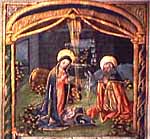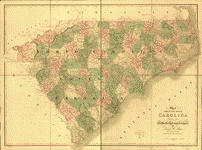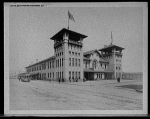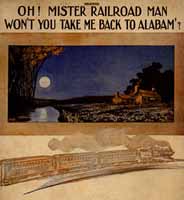Today in History: December 25
Welcome Christmas

Nativity Scene Illumination [detail], photograph of an illuminated manuscript page
Theodor Horydczak, photographer, circa 1920-1950.
Washington as It Was, 1923-1959
On December 25, Christians around the world celebrate the birth of Christ. The origins of the holiday are uncertain; by the year 336, however, the Christian church in Rome observed the Feast of the Nativity on December 25. At that time, Christmas coincided with the winter solstice and the Roman Festival of Saturnalia. Today, observations of Christmas incorporate the secular and religious traditions of many cultures, from the ancient Roman practice of decorating homes with evergreens and exchanging gifts at the New Year to the Celtic Yule log.
For Margaret Davis, born in Clarke County, Georgia in 1887, Christmas brought to mind memories of the food and family that filled her parents' home between Christmas Eve and New Year's Day. She recalled:
Mama killed turkeys, chickens, and cooked cakes for two weeks…That was the way we spent our Christmas then, eating and dancing, and parties all through the week…There was not so many things for children to get then, as they have now, but we got many nice things."Mrs. Margaret Davis,"
Grace McCune, interviewer, December 9, 1938.
American Life Histories, 1936-1940
Alan Wallace of Brookfield, Massachusetts cherished his mother's tradition of making Christmas gifts by hand. When she was a girl during the Civil War, he recalled, her family "couldn't afford to spend money on anything but food…The habit stuck to her and so, when my brothers and I came along she taught us to do many things that ever since makes Christmas to me." Preparations began, Wallace remembered, when the family went to the seashore for their summer vacation:
Half the fun of going was the finding of shells to take home to make into Christmas presents. We'd pick up the prettiest clam shells and scallop shells, a whole basket full, and then when we got back home, we'd paint them in the evenings—make ash trays, pin trays and—and—oh, yes, paper weights and sometimes door stops…As I look back on it now I realize that some of them were pretty awful but Mother always seemed delighted with our efforts, no matter how feeble they proved to be…To Father and Mother Christmas meant love and love means happiness—doesn't it?"Alan Wallace,"
Louise G. Bassett, interviewer, December 1, 1938.
American Life Histories, 1936-1940

Children with Tricycle and Wagon Next to Christmas Tree, circa 1920-1950.
Washington as It Was, 1923-1959
- Listen to Christmas music sung in a variety of languages. Search on Christmas in California Gold: Folk Music from the Thirties, 1938-1940.
- Search on Christmas in the following American sheet music collections to find songs appropriate to the season, such as the undated song sheet "Christmas Carol" and "Christmas and New Year Musical Souvenir" (1863):
- View the film TR calls on neighbors at Christmas, 1917 in the collection Theodore Roosevelt: His Life and Times on Film.
- The American Memory collections contain a panoply of holiday pleasures, from festive photographs of Christmas cards, to Christmas trees, decorated homes, choirs, nativities, and Santa Claus. To locate more images, search the American Memory photographic collections on Christmas.

St. Peter's Evangelical Lutheran Church, Altar at Christmas, Washington, D.C., circa 1920-1950
Washington as It Was, 1923-1959 - Search the American Life Histories, 1936-1940 collection on Christmas or Christmas Day to find more memories of the season. After retrieving a list of hits, go to any item and use the BEST MATCH link in the page header to jump to the most relevant segment of the piece.
Topics range from Christmas in Cuba, described by Miami resident "Mr. Pedro Barrio," to a native Spaniard's perspective on Christmas in Vermont in "From Quarry to Cemetery." "I Have Talked with Grandma Handy" includes recollections of Christmas in South Carolina during the Civil War from the perspective of a white woman who lived through it; in "Ella Lassiter (Life and Songs in Slavery)," a woman born in 1859 describes Christmas on a Georgia plantation. - Search on the term Christmas in Prairie Settlement, 1862-1912 to learn how the holiday was celebrated by settlers on the Great Plains. Read, for example, Ella E. Oblinger's January 12, 1880 letter to her grandparents in which she tells them about her Christmas gifts, including a "red oil calico dress" and a candy apple.
"Venid Pastores" ("Come Shepherds")
Christmas Song from Puerto Rico, in Spanish
Aurora Calderon, unaccompanied vocals,
April 10, 1939.
![]()
Listen to this recording
(Real Audio format)
![]()
Listen to this recording
(wav format, 2,400 Kb)
"Pastorak Orven Deznek" ("The Shepherds are Rejoicing") Hungarian Christmas Song
Mary Gaidos and friends, unaccompanied vocals
December 31, 1939.
![]()
Listen to this recording
(Real Audio format)
![]()
Listen to this recording
(wav format, 3,170 Kb)
California Gold: Folk Music from the Thirties, 1938-1940
Choo! Choo!

Map of North and South Carolina exhibiting the post offices post roads, canals, rail roads &c.,By David H. Burr. (Late topographer to the Post Office.) Geographer to the House of Representatives of the U.S.
London, 1839.
Railroad Maps, 1828-1900
On Christmas Day, December 25, 1830, the first regularly scheduled passenger train in the United States began operation. Chartered in 1827, the same year as the Baltimore and Ohio Railroad, the South Carolina Canal and Railroad Company steamed out of Charleston along a six mile line of track. According to the previous day's Charleston Mercury regular times for leaving the station would be "8 o'clock, at 10 A.M., at 1, and at half past 3."
The new service's locomotive steam engine, named Best Friend, purchased from one Mr. E. L. Miller, was the first in the U.S. to pull an entire string of cars. According to the Mercury article, "It is said to have moved on some occasions at the rate of 30 miles per hour…When drawing two Cars with 41 Passengers, it went at the average rate of nearly 16 and where the Road was straight, at the rate of 20…per hour." This breakneck speed was achieved by a six horse power engine weighing three tons "exclusive of the wood and water for keeping it in continued action."
Just prior to and immediately following the trains's successful run, the Mercury also carried the following advertisement:
RAIL ROAD LABORERS, — Wanted to Hire, from 1 to 200 HANDS, by a Contractor, to work on the Rail Road by the year, for whom liberal wages will be given. Payments will be made as follows: at the expiration of the first 90 days, and after that, every 30 if required. Apply to Capt. D. Kane

Union Station, South Carolina, circa 1910-1920.
Touring Turn-of-the-Century America, 1880-1920
Enough workers must have applied because over the next three years the South Carolina Canal and Railroad Company became, for a time, the world's longest railway line. The company was the earliest predecessor of the Southern Railway Company, formed by financier J. P. Morgan, which grew out of the realignment of southern railways following the Civil War.
- Search on the term South Carolina, or any other state, in Railroad Maps, 1828-1900 to see maps related to the development of transport in that state. The Railroad Maps collection illustrates the growth of travel and settlement as well as the development of industry and agriculture throughout the U.S.
- Search the American Memory photographic collections on the term Charleston, South Carolina for images of the city.
- Search on railroad and train in the collection The John and Ruby Lomax 1939 Southern States Recording Trip to listen Southern songs and "hollers" featuring railroad themes. The song "I Ain't Goin' Work on the Railroad" was performed by Viola Brown at the home of Mrs. Genevieve W. Chandler at Murrells Inlet, South Carolina on June 8, 1939.
- Search on railroad in California Gold: Folk Music from the Thirties, 1938-1940 to read a transcript of the lyrics of the ballad of legendary railroad man Casey Jones and to listen to several performances of this folksong.
- Search on railroad and train in the following American sheet music collections to find music such as "Standing on the Platform, Waiting for the Train" by F. L. Martyn (1870), "Oh! Mister Railroad Man Won't You Take Me Back to Alabam'?" by Henry I. Marshall (1914), and "The Charming Young Widow I Met in the Train," (undated song sheet):
- Music for the Nation, 1870-1885
- Historic American Sheet Music, 1850-1920
- America Singing: Nineteenth-Century Song Sheets

"Oh! Mister Railroad Man Won't You Take Me Back to Alabam'?", by Henry I. Marshall, 1914
Historic American Sheet Music, 1850-1920 - Search the Today in History Archive on the term railroad to learn more about the importance of railroads in the shaping of the nation. Features include the charter of the Baltimore & Ohio Railroad, the opening of the Oahu Railway and Land Company, the completion of the Florida East Coast Railway, and the first train robbery.